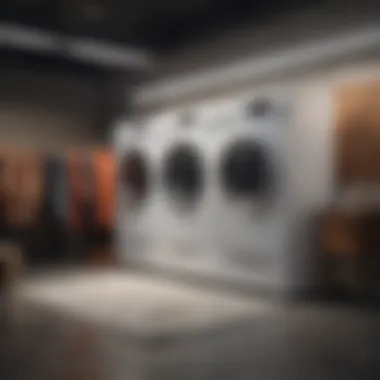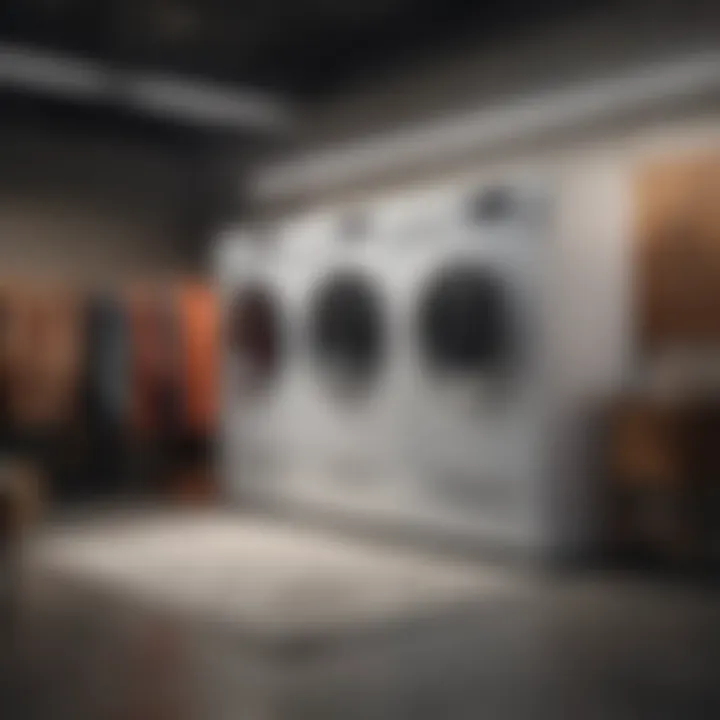Mastering Laundry: Effective Washing and Drying Tips


Intro
Laundry might seem like just another routine task, but there’s more to it than simply tossing clothes in the washer. Navigating the ins and outs of this household chore can turn tedious if you don’t know what you’re doing or how to do it efficiently. From sorting garments to selecting the right settings, each step carries significance that can either save you time or lead to frustrating mishaps.
This guide is not only about getting your clothes clean but also about maintaining their quality while being mindful of our environment. It caters to everyone from homemakers to busy individuals who strive for an effective laundry regimen. Within these pages, you will find tips on fabric care, insights on optimizing your washing machine's settings, and practical advice on drying methods that can help you get the most out of your laundry day.
As we delve into this comprehensive exploration of laundry practices, be prepared to rethink how you approach this vital part of household management.
Design Inspirations
Although it may seem off-topic, the aesthetics of your laundry space can influence your approach to the task. Tranquil colors and stylish designs can mitigate the laundry blues.
Trending Styles
A functional yet chic laundry room can serve as an inspiration for your routine. Here are a few tips to uplift your washing area:
- Incorporate open shelving for easy access to detergents and fabric softeners.
- Use baskets or bins with different labels for organization.
- Opt for calming colors, like soft blues or greens, which create a serene atmosphere.
Color Palettes
Consider neutral palettes mixed with vibrant accents. For instance, pairing white shelves with pastel storage containers can create a fresh look, making the task feel less daunting.
Practical Laundry Techniques
Laundry isn’t just about washing and drying; it’s also about knowing how to care for different fabrics efficiently.
Washing Procedures
Understanding your washing machine settings is key. Don’t be afraid to dive into the manual, it can be your best friend:
- Cold water settings conserve energy and prevent colors from fading.
- Delicate cycles are perfect for lingerie and fancy fabrics to avoid damage.
- Heavy-duty cycles are ideal for soiled work clothes.
Drying Methods
Whether you hang dry or use a dryer, knowing your fabric types will help:
- Cotton and linens can withstand higher heat, unlike delicate fabrics such as silk.
- Air drying preserves fabric quality and saves energy.
Keeping different fabrics sorted not only helps in preserving their longevity but also enhances the overall appearance (fewer wrinkles make a world of difference).
Eco-friendly Laundry Practices
In today's world, sustainability is more important than ever. Here’s how to be eco-conscious:
- Use eco-friendly detergents that are less harmful to the environment.
- Consider line drying whenever possible to cut down on energy use.
- Wash with full loads to maximize water and energy efficiency.
Closure
Arming yourself with the right knowledge about laundry practices can convert a mundane task into a well-organized and efficient process. By focusing on methods tailored to specific fabric types and uplifting your laundry area’s design, you enhance not just the practice, but the experience altogether. An efficient laundry routine is a step towards a more organized and polished household.
Understanding Laundry Basics
Understanding laundry basics is essential to mastering an effective laundry routine. It sets the foundation for how to treat fabrics, prioritize garment care, and make the whole process much smoother. The right knowledge can save time, money, and frustration. Gaining a solid understanding of laundry basics allows you to tackle any type of load effectively, ensuring your clothes not only come out clean but also last longer.
The Laundry Cycle Explained
The laundry cycle can be thought of as a three-step process: washing, rinsing, and drying. Each step works in concert to ensure dirt and stains are effectively removed while preserving the integrity of the fabric. Here’s a closer look:
- Washing: This is where the magic happens. Detergent does its job, loosening dirt and stains from fabric fibers in water.
- Rinsing: After washing, the machine expels the soapy water and rinses the fabric with clean water to wash away detergent residues.
- Drying: Finally, the clothes are dried which can be done through different methods: tumble drying, air drying, or line drying. Each method has its pros and cons which I'll dive deeper into later.
When well understood, the laundry cycle can become second nature, not unlike riding a bike.
Importance of Sorting Laundry
One of the cornerstones of a successful laundry day lies in sorting your clothes correctly. It’s not just about tossing everything into the wash and hoping for the best.
Color Separation
Color separation involves dividing your laundry into whites, colors, and sometimes darks. This process is vital because it prevents color bleed, where darker dyes seep into lighter fabrics, ruining your favorite shirt. It’s a simple but effective strategy that minimizes the risk of discoloration. Additionally, it helps to maintain the original vibrancy of fabrics longer.
- Key Characteristic: Preventing dye transfer.
- Benefits: Helps preserve fabric colors which means clothing lasts longer and looks better.
- Drawbacks: While it does require extra time and organization, the benefits significantly outweigh the minor inconvenience.
Fabric Type Considerations
Fabric type considerations take into account the individual characteristics of the materials you’re washing. Not all fabrics react the same when it comes to cleaning. Some may require a gentle wash, while others can withstand regular settings without a hitch.
- Key Characteristic: Different fabrics have unique washing needs.
- Benefits: Using the appropriate wash settings prolongs the life of your clothing and keeps them looking new.
- Drawbacks: This can lead to a bit of extra effort, especially if you're unsure about what cycle to choose.
Handling Delicates
Handling delicates is another critical aspect. These items often require special care to prevent damage from harsh cycles or high temperatures. Think about silk blouses or lace garments; they need a tender approach to avoid tears or fading.
- Key Characteristic: Gentle handling to prevent damage.
- Benefits: Protecting more fragile items means you can enjoy wearing them for years.
- Drawbacks: The need for separate washes may take additional time and effort, but it’s worth every minute when you consider the longevity of your garments.
By grasping these laundry basics, you're not just cleaning your clothes—you're extending their life and enhancing your overall wardrobe experience.
In summary, understanding laundry basics and sorting correctly ensures you’ll get the most out of every wash. Your clothes will feel fresher, look brighter, and last longer.
Selecting Detergent and Fabric Softeners
Choosing the right detergent and fabric softener is a crucial step in the laundry process. It goes beyond simply selecting what’s on sale or most popular. The right products can enhance cleaning performance, maintain fabric integrity, and contribute to a more effective laundry routine overall. In households, the choices in detergents and softeners can vastly differ depending on family needs, types of fabrics, and even personal preferences. Understanding their properties and benefits allows for a more informed choice that aligns well with your laundry habits.


Types of Detergents
Liquid vs. Powder Detergents
Liquid and powder detergents are both staples in the laundry landscape, each with its unique offerings. Liquid detergents dissolve easily in water, making them a practical choice, especially for cold washes. This is particularly helpful for quickly removing greasy stains or food residues, which can be real troublemakers. On the flip side, powder detergents tend to be more effective on older stains, thanks to their higher bleach content. They might need a little extra help in cold water, but their bulk and packaging are often more eco-efficient and wallet-friendly.
Here’s a quick comparison:
- Liquid Detergent:
- Powder Detergent:
- Advantages: Easy to measure, works well in cold water, effective at removing grease.
- Disadvantages: More prone to spills, may require more than powders for tough stains.
- Advantages: Often more cost-effective, longer shelf life, better on tough stains.
- Disadvantages: Can leave residues if not dissolved properly, may clump in humid environments.
Pods and Their Advantages
Pods have surged in popularity owing to their convenience and precise dosing. When you pop one into the wash, you can rest assured that you’re using the right amount of detergent without fussing over measurements. They're particularly advantageous for busy households where time-saving is key. However, it's essential to be cautious as toddlers might mistake them for candy, leading to hazards.
- Key Features of Pods:
- They come as pre-measured single doses.
- Often contain concentrated formulas that provide a powerful punch per load.
Some upsides include:
- Convenience: No measuring, no mess.
- Effectiveness: Great stain-fighters with improved formulations.
However, they might not be as eco-friendly and can be more expensive per load compared to traditional detergents.
Eco-Friendly Options
As the world leans more towards sustainability, eco-friendly detergents have gained traction. These products are formulated to minimize environmental impact while still offering effective cleaning power. Utilizing biodegradable substances and avoiding unnecessary chemicals, these options cater to those who wish to do their bit for the planet while launder their clothes.
- Characteristics of Eco-Friendly Detergents:
- Biodegradable components and vegan formulations.
- Typically free from synthetic fragrances and dyes.
Some benefits include:
- Environmental Responsibility: Reduced harmful chemical runoff.
- Gentle on Skin: Great for sensitive skin or allergies.
Nonetheless, it is pertinent to note that they may sometimes fall short against stubborn grime compared to conventional detergents.
Fabric Softeners: Do You Need Them?
Now that the necessities of detergent types are covered, let’s address the fabric softeners. Many people wonder if they really need them, especially given their popularity. Fabric softeners can aid in reducing static, softening fabrics, and providing a pleasant scent to laundry. However, they might not be suitable for every fabric type.
- Pros of Fabric Softeners:
- Cons of Fabric Softeners:
- Softening clothes, reducing wrinkles, and making ironing much easier.
- Providing fresh fragrance to laundered items, which gives a neat impression.
- They can sometimes reduce the absorbency of towels and activewear.
- If overused, they can cause a buildup on fabrics.
In summary, while fabric softeners can add charm to your laundry routine, understanding when and how to use them is pivotal to maintaining fabric quality. Consider your fabric needs, personal preferences, and if the benefits outweigh any potential drawbacks in your laundry regimen.
Washing Techniques: Optimizing the Process
Laundry isn't just about throwing clothes in the machine and waiting; it involves understanding the specifics of washing techniques that can make or break the effectiveness of the process. This section points out various methods to make washing efficient while considering fabric care, energy consumption, and overall time spent on laundry. Choosing the right washing techniques means recognizing the needs of different garments, ensuring the longevity of your clothes, and saving time and resources in the long run.
Choosing the Right Cycle
Each washing cycle has its own purpose, and knowing when to use each is key to keeping your laundry routine up to snuff.
Normal Wash
The Normal Wash cycle is a staple of the laundry world, designed specifically to handle the bulk of everyday laundry without breaking a sweat. This cycle is perfect for durable fabrics like cotton. It generally uses a faster spin speed with a more intense wash action, making it effective for removing everyday dirt and stains.
The biggest draw of using Normal Wash is its efficiency—getting clothes clean in a straightforward manner. However, the downside might be that it's not gentle on delicate fabrics. So, use this cycle wisely, directing it towards those trouble-free items in your wardrobe while saving the gentle cycles for your more vulnerable clothes.
Gentle Cycle
When it comes to taking care of fragile clothing, the Gentle Cycle is a household hero. It modifies the wash action to decrease agitation and uses slower speeds during the spin cycle, which helps prevent damage to delicate fabrics. This cycle is a lifesaver for items made of silk, lace, or those embellished with intricate details.
Opting for the Gentle Cycle means you can keep your favorite garments for a lot longer without fraying or stretching them out of shape. On the flip side, the cycle might struggle to remove heavier stains, requiring further attention post-wash.
Heavy Duty
Heavy Duty cycles are your go-to solution for those tough laundry jobs. Think work clothes, mildewy towels, or anything that’s seen some serious action. This cycle works harder and longer to tackle the grit and grime that normal washing just can’t cut through. It operates at higher agitation speeds, which is great when you want to take on stubborn stains.
The downside, however, is that this cycle can be overkill for everyday items, using more water and energy in the process. Always assess the laundry load to determine whether this cycle is indeed necessary.
Managing Water Temperature
Washing your clothes isn’t just about the cycle; the temperature of the water plays a significant role too. Selecting the right water temperature can significantly affect the cleanliness and lifespan of your garments.
Cold Water Benefits
Using Cold Water has gained popularity for its efficiency and effectiveness. It’s particularly beneficial for dark colors, as it helps prevent fading and bleeding. Not only does it preserve the integrity of your fabrics, but it also saves energy since heating water can consume a good chunk of your laundry expenses.
While cold water is excellent for general cleaning, it might not cut it for heavily soiled items, where some warm water might do the trick. Just remember to check clothing labels and treat stubborn stains separately.
Hot Water Considerations


Hot Water is often touted as the ultimate option for sanitizing and deep cleaning. For white cottons or heavily soiled bedding, hot water can be highly effective in removing grime and bacteria. However, it's worth noting that using hot water isn't suitable for all fabrics, as it can lead to shrinkage and damage on delicate fibers.
So, if you opt for Hot Water, ensure it’s only used on materials that can handle the heat without turning into a shrunken version of themselves.
Warm Water Usage
Warm Water strikes a balance between hot and cold, providing a middle ground that works well for a diverse range of fabrics. This temperature is particularly useful for synthetic fabrics like polyester or blends that might get too hot in boiling water but also need a bit more than just cold water cleaning. It can be a versatile choice that lends itself to both pre-sorted colors and mixed loads.
It’s a good idea to consider what you’re washing and the type of stains you’re dealing with to decide if warm water is the right fit for that specific load.
Time-Saving Tips
Laundry sometimes feels endless, but there are ways to secure more time in your day.
Batch Washing Strategies
Batch Washing involves gathering items that can be washed together based on color, fabric type, or washing method. By organizing your laundry into batches, you can run a single load instead of several smaller ones, saving water, detergent, and precious time. This approach is particularly beneficial for larger households, where clothing accumulates quickly.
Using batch washing is a game-changer for efficiency; however, make sure you don’t mix delicate fabrics with heavy-duty items, as it might compromise the washing quality of both.
Pre-Treatment Methods
Pre-Treatment methods can save your laundry from catastrophic stains before they even hit the wash. This strategy involves treating stains or soiled areas prior to washing, using a stain remover or even a simple soap solution. By applying a pre-treatment, you can lighten the burden on your machine and increase the chance of successful stain removal during the wash cycle.
The benefit here is clear: pre-treating can lead to cleaner clothes with less effort over time, as opposed to numerous cycles to combat stubborn stains. The downside? Some pre-treating methods may require time for the solution to work its magic before you wash.
For a truly efficient laundry process, tailor your washing techniques to the specific needs of your fabrics while staying mindful of energy and water use.
By understanding and adapting your washing practices, you're not just keeping your wardrobe fresh; you're also contributing to a more eco-friendly home. Taking these insights on board will definitely make a significant difference in the overall laundry experience.
Drying Techniques: Effectively Handling Post-Wash Care
When it comes to laundry, the washing phase often takes the spotlight. However, drying techniques are integral to ensuring clothing retains its shape, texture, and color. Post-wash care deserves just as much attention as the washing itself. Proper drying methods not only enhance garment longevity but also prevent certain common problems like shrinkage and fading. In this section, we will delve into various drying techniques, weighing their benefits and considerations, to empower you in your laundry routine.
Choosing the Right Drying Method
Tumble Drying
Tumble drying is perhaps the most popular drying method. It utilizes a rotating drum to dry clothes quickly by blowing heated air through. This technique is efficient and saves considerable time, making it ideal for busy households.
One of the key characteristics of this method is its adjustable heat settings, allowing flexibility based on fabric type. For instance, delicate fabrics can be dried on lower heat settings to minimize damage.
Additionally, tumble drying can reduce wrinkles, which is a boon for garments that may otherwise require ironing. But like everything, it has its downsides. Some fabrics, like certain synthetics and delicate items, may not fare well in a dryer. Hence, it’s crucial to check care labels to avoid mishaps.
Air Drying
Air drying, on the other hand, champions a more natural approach. This method is simple: hang your wet clothes on a line or rack, allowing the ambient air to do its work. The key highlight of air drying is its eco-friendliness; it consumes no electricity and is gentler on fabrics, preserving their integrity. One unique feature of air drying is its versatility. You can dry large items like blankets or small delicate garments without the worry of shrinkage. This method also helps to preserve colors better than tumble drying, which can sometimes cause fading. However, it does demand more time and can be dependent on weather conditions.
Line Drying Considerations
Line drying is essentially a specific type of air drying but deserves its own mention due to its numerous advantages. It can be done indoors or outdoors, making it a flexible option. A key benefit of line drying is that it doesn’t subject fabrics to the tumbling and heat exposure that can weaken fibers over time. Additionally, line drying can add a fresh, outdoor scent to your laundry, which many find appealing. However, as with air drying, the process can take longer than using a dryer, and items may become stiff if not removed promptly.
Dryer Settings Demystified
Understanding Timed Drying
Timed drying gives you control over how long your clothes are exposed to heat. This feature is advantageous if you’re aiming to match specific drying times for different fabric types. For example, heavier towels require more time than light blouses. A unique aspect of this setting is its flexibility. It allows you to adjust the drying cycle based on real-time assessments, rather than relying on preset cycles. On the flip side, timed drying can sometimes lead to under-drying if your timing is off, leaving you with damp clothes.
Selecting Moisture Sensors
Moisture sensors are a modern breakthrough in dryer technology. They detect the moisture level in the drum, automatically adjusting the drying time based on how wet the clothes are. This feature not only saves energy but also minimizes the risk of over-drying, which can be detrimental to sensitive fabrics.
What sets moisture sensors apart is their efficiency. By ending the cycle just as clothes reach the optimal dryness level, they prevent fabric damage and extend the life of your garments. However, not all dryers come equipped with this advanced feature, so it’s worth considering when selecting a new appliance.
"The right drying technique can extend the life of your garments and keep them looking fresh and new. Choose wisely!"
In summary, understanding how to effectively manage your post-wash care through drying techniques enables you to enhance your laundry practice. Each method—be it tumble drying, air drying, or line drying—has unique characteristics and advantages that can fit different lifestyles and preferences. With this knowledge, you can streamline your routine and optimize the longevity of your clothes.
Addressing Common Laundry Issues
Laundry isn't always a walk in the park; it often comes with its fair share of obstacles. Addressing common laundry issues is crucial to maintaining the quality and longevity of your clothes. These issues can range from stubborn stains to unintentional fabric damage, and if not handled properly, they can leave your garments looking worse for wear. By recognizing these challenges and employing effective strategies to tackle them, individuals can vastly improve not only the appearance of their laundry but also the efficiency of their washing practices.
Dealing with Stains
Stains are an unwelcome reality for anyone who wears clothes, and they come in all shapes and forms. From that splatter of tomato sauce on a crisp white shirt to the unexpected ink mark on your favorite pair of jeans, getting a grip on stains is key to effective laundry management.
Common Stain Types
Understanding the common stain types can make a world of difference in laundry success. These usually include food stains, like those from sauces or grease; beverage stains such as coffee and red wine; and even biological stains like blood or sweat. Each of these stains carries distinct characteristics that require tailored treatment methods. For instance, oil-based stains often need a different approach than those from fruit juices. Identifying the stain type allows you to act quickly, improving your chances of total removal, making it a fundamental aspect of stain management.
- Remember, the sooner you address a stain, the better!
Effective Removal Methods
Equipped with the knowledge of stain types, moving on to effective removal methods is essential. These methods vary from pretreating stains with specific solutions to varying temperatures and washing cycles. The unique feature of targeted stain removers lies in their formulation; they are specifically designed to break down the compounds that make up certain stains. For example, a biological stain remover contains enzymes that help digest protein stains effectively. Using the right method not only saves your favorite clothing but also enhances the likelihood of stain complete removal, making it a highly strategic choice in the guide to better laundry practices.
Prevention Tips
The best offense is a good defense, and this rings true in laundry as well. Prevention tips for stains can save you a lot of headaches down the line. You might think about using aprons when cooking or opting for darker clothing when dining out. Familiarizing yourself with fabric types and their stain resistance can further support your prevention efforts. Stains can be tricky, but taking a proactive stance will definitely lessen your laundry woes.
Preventing Shrinkage and Damage
While stains are often top-of-mind, preventing shrinkage and damage is another hurdle that laundry enthusiasts face. Clothes can lose their fit or even sustain permanent injuries if not treated with care.
Understanding Fabric Composition


At the very foundation of preventing damage lies the understanding of fabric composition. Different materials, be it cotton, wool, or synthetic blends, respond uniquely to heat, moisture, and agitation. For example, cotton generally withstands high temperatures, while wool is more delicate and can shrink drastically if subjected to the wrong cycle.
Recognizing the properties of each fabric type enables you to choose the correct wash and dry settings, thus significantly reducing the chance of damage and prolonging the life of your wardrobe.
Suitable Washing and Drying Practices
Finally, implementing suitable washing and drying practices rounds off the effort to safeguard your garments. This involves utilizing gentle cycles for delicate items and avoiding high-temperature drying, which can warp and shrink fabric. For example, line drying can provide a more gentle alternative for air drying fragile items, allowing them to keep their shape and size.
Considering proper washing and drying techniques can be the difference between a well-maintained wardrobe and a closet filled with garments that are shrunken or otherwise damaged. The right approach can enhance fabric longevity and performance, ensuring your laundry stands the test of time.
Eco-Friendly Laundry Practices
In our increasingly eco-conscious world, adopting eco-friendly laundry practices is not just a trend; it's a necessity. Every time you toss clothes into the washing machine, you're making choices that impact the environment. The way we wash and dry our garments can either contribute to or mitigate problems like water wastage, plastic pollution from detergents, and excessive energy consumption. By incorporating eco-friendly strategies into your laundry routine, you not only elevate your cloth care game but also promote sustainability for future generations.
Sustainable Detergent Options
When it comes to making eco-friendly choices, the type of detergent you use plays a crucial role. Traditional laundry detergents often contain harsh chemicals, fragrances, and phosphates that can harm aquatic ecosystems and contribute to water pollution. That’s why opting for sustainable detergent options is an essential step.
Sustainable detergents are typically made from biodegradable ingredients, reducing their impact on the environment. Brands like Seventh Generation and Ecover have carved their niche in this space, proving that you can achieve clean laundry without sacrificing the planet. These detergents work just as effectively in removing stains, while being kinder to both your clothes and the Earth. Moreover, consider purchasing products with minimal or recyclable packaging to further reduce your environmental footprint.
Energy-Efficient Washing and Drying
Energy efficiency is another critical element in eco-friendly laundry practices. By reducing energy consumption during washing and drying, we can contribute to lower greenhouse gas emissions and decreased energy bills. Here are two smart strategies to help you in this area:
Choosing Energy Star Appliances
When it comes to selecting washing machines and dryers, investing in Energy Star-rated appliances is a wise move. These models are designed to use significantly less water and energy compared to standard appliances. A notable characteristic of Energy Star appliances is their efficiency; they perform the same tasks but with about 20-30% less energy. For the environmentally conscious homeowner, this is both a cost-effective and popular choice.
One unique feature of many Energy Star washing machines is their ability to sense load size and adjust the water level accordingly, ensuring minimal resource usage. Though these appliances might come with a higher upfront cost, the long-term savings on utility bills can be substantial, making them a worthwhile investment.
"Investing in Energy Star appliances is not just saving pennies, but helping to save the planet."
Using Cold Water Effectively
Using cold water for laundering may seem like a small change, but it can make a significant impact. Cold water washing is effective for a majority of clothing, helping to maintain colors, preserve fabric integrity, and save energy.
With the key characteristic of cold water washing being its gentle approach to garments, it's particularly beneficial for delicate fabrics that may shrink or fade when exposed to high temperatures. Additionally, washing in cold water can lower energy costs, as heating water accounts for up to 90% of the energy consumed during a wash cycle.
However, it’s essential to recognize that certain heavily soiled items might require hotter temperatures for optimal cleaning. An effective compromise here would be using cold water for light to medium loads while reserving hot washes for heavily soiled clothes. This balance allows for both effective cleaning and eco-conscious habits.
In summary, eco-friendly laundry practices can enhance your laundry experience by being planet-friendly while also being easy to implement. From the right detergents to energy-efficient appliances and smart usage of water temperature, there are plenty of strategies to adopt. Each small shift in your habits can collectively lead to substantial positive effects on the environment.
Organizing Your Laundry Space
In the whirl and swirl of modern life, a well-organized laundry space can feel like a breath of fresh air. Keeping things tidy not only makes the laundry process smoother but also cultivates a sense of peace amidst the routine chores. An orderly laundry area allows you to find what you need without hunting around like a squirrel in winter. By maximizing efficiency and simplifying accessibility, a thoughtfully organized laundry space has the power to transform mundane tasks into manageable ones.
Utilizing Storage Solutions
Having suitable storage solutions is crucial for any laundry setup. They can reduce clutter and keep your space functional. When everything’s in its place, you can spend less time searching and more time enjoying the lighter side of laundry.
Bins for Sorting
Bins for sorting are indispensable in creating an organized laundry routine. They come in various sizes, colors, and materials, making it easy to allocate specific bins for whites, colors, and delicates. The key characteristic of these bins is their ability to streamline the sorting process from the very start. This ensures that when you're ready to wash, everything’s prepped and ready to go, reflecting thoughtful planning on your part.
The unique feature of bins for sorting is their versatility—they can be stacked, labeled, or even undercover when not in use. This adaptability not only keeps your laundry space visually appealing but also functional. However, do consider the number of bins you need. Having too many could create confusion and clutter, rather than resolve it.
Hanging Organizers
While bins are great for storage, hanging organizers take advantage of vertical space often overlooked. These nifty tools can be fitted on doors or walls, offering a perfect spot for keeping detergents, fabric softeners, and dryer sheets. They free up precious counter and floor space, creating a more open feel in your laundry room.
The key characteristic of hanging organizers is the ease of access they provide. You can simply grab what you need without digging through drawers or bins. One particular advantage is that they help with visibility. You can see at a glance what supplies you have, and you won’t be caught short when you’re about to start a wash cycle. However, it is essential to ensure they are securely mounted to avoid accidents with spills.
Creating a Functional Workflow
A well-thought-out workflow within your laundry space can significantly enhance efficiency. It’s not just about cleaning clothes; it’s about optimizing the entire process from start to finish.
Designing an Efficient Space
The significance of designing an efficient space cannot be understated. Whether it's a compact nook or a fully-fledged laundry room, the layout should encourage smooth transitions between washing and drying. The centerpiece of an efficient design is often the proximity of the washer and dryer. If they can be side-by-side, it saves you from unnecessary trips across the room.
An efficient layout should also consider the flow of tasks. A nearby folding surface or drying rack can make all the difference. While the space may be limited, creative solutions like multipurpose furniture can play a role in utilizing every square inch while still allowing for movement.
Recommended Layouts
Recommended layouts serve as guidelines that folks can adapt to their own spaces. A U-shaped layout, for instance, can optimize workflow by placing the washer, dryer, and folding area in a convenient loop, minimizing unnecessary back-and-forth.
Alternatively, an L-shaped design can make use of corners, which are typically under-utilized. Whatever layout you choose, it should align with your laundry habits. Take into account the volume of laundry you handle, as a family of four will require more space than a single individual. Remember, every inch counts in making your laundry journey efficient and user-friendly.
Culmination: Refining Laundry Practices
In this article, the exploration of laundry practices has been extensive. Refining laundry practices is where all the learning comes to fruition. It is no t just about throwing clothes into the washing machine and hoping for the best. There is a rhythm to it, a dance, if you will, that involves understanding the nuances of fabrics, detergents, and drying methods. Embracing these principles can lead to cleaner clothes, prolonged fabric life, and even a lighter environmental footprint.
The importance here cannot be overstated; when one masters the hows and whys of laundry, it transforms what is often considered a mundane chore into a more methodical and pleasing undertaking. The financial benefits also start to add up. For example, knowing the right washing cycles can minimize electricity consumption, thus trimming that monthly bill. Plus, keeping fabrics in tip-top shape means less frequent replacements, saving hard-earned cash.
Summary of Key Practices
Here is a recap of the key takeaways:
- Sorting is Essential: Always separate your laundry by color and fabric type to avoid any mishaps. Delicates require special care, so don’t lump them with heavy items.
- Choose the Right Detergent: Understand the differences between liquid, powder, and eco-friendly options. Each has its pros and cons, and your choice can impact wash effectiveness.
- Optimize Washing Techniques: Utilize appropriate washing cycles according to fabric type. Cold water is not only economical but often gentler on clothes.
- Post-Wash Care Matters: Select drying methods that complement fabric needs. Sometimes going old-school with air drying can keep clothes in great shape.
- Stay Eco-Conscious: Invest in energy-efficient appliances and detergents. Small changes can make all the difference for the planet.
Encouragement for Continued Improvement
Laundry skills aren’t set in stone; they should be constantly evolving. Each wash day is an opportunity for refining your methods and approaches. Pay attention to outcomes. Has that bright white shirt faded into something more beige? Perhaps it’s time to reconsider your wash settings or detergent choice.
Explore current laundry trends, maybe even check social media platforms. There are always tips and tricks floating around places like Reddit or Facebook, where fellow laundry aficionados share their wisdom. Staying informed doesn’t just enhance laundry outcomes; it also builds a sense of community and connection to common experiences.
"Change is the only constant in life." This quote rings true when it comes to laundry practices. Don’t hesitate to experiment with your routine and adopt new habits as you discover what works best for you.
In closing, refining your laundry practices is an ongoing journey. With this guide, we hope readers feel equipped and inspired to master their laundry processes, turning what was once a tedious task into a well-oiled operation.



